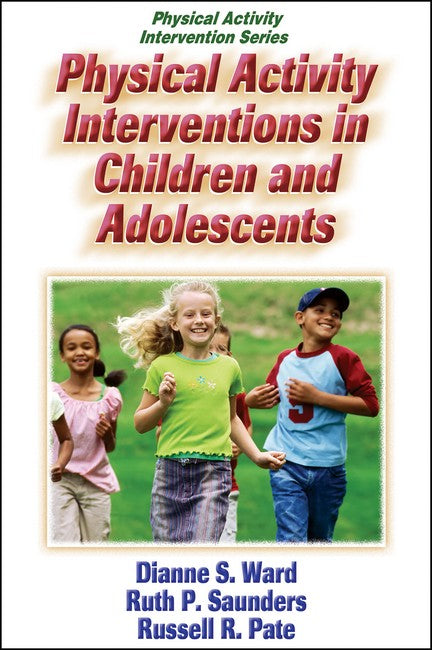Dianne Stanton Ward, EdD, is a professor and director of the Intervention and Policy Division in the department of nutrition at the University of North Carolina at Chapel Hill. Dr. Ward has more than 30 years' experience in the development and evaluation of physical activity programs for children and adolescents. She has received 10 years of National Institutes of Health (NIH) funding for intervention research and is a member of the NIH Study Section on Community Influences on Health Behavior, a Health of the Public Integrated Review Group. Dr. Ward has received several awards, including the Distinguished Alumni Award in 2001 from the College of Health and Human Performance at the University of North Carolina at Greensboro. She is a fellow in the American College of Sports Medicine, and she is a member of the American Public Health Association, the Association for Nutrition Science, the North American Association for the Study of Obesity, the American Alliance for Health, Physical Education, Recreation and Dance (AAHPERD), and the North American Society for Pediatric Exercise Medicine. In her leisure time she enjoys hiking, playing golf and tennis, reading, and gardening. Ruth P. Saunders, PhD, is an associate professor in the department of health promotion, education, and behavior in the Arnold School of Public Health at the University of South Carolina at Columbia. Dr. Saunders has worked with physical activity interventions for children and adolescents for more than 10 years and has taught health behavior theory and health promotion program planning and evaluation for 20 years. She has also worked with schools and school districts on health and wellness issues for 18 years. Dr. Saunders was on the team that developed the Centers for Disease Control and Prevention guidelines for promoting physical activity in school and community settings and has been an active member of a successful research team in obtaining funding and publishing in the area of child and adolescent physical activity and interventions. She has also been an effective collaborator with community organizations and agencies, including schools. Dr. Saunders has won teaching and research awards and is a member of the American School Health Association, AAHPERD, the Society for Public Health Education, and the American College of Sports Medicine. She enjoys jogging, cycling, gardening, and baking in her spare time. Russell R. Pate, PhD, is a professor in the department of exercise science in the Arnold School of Public Health at the University of South Carolina at Columbia. Dr. Pate has 30 years of experience in researching the issues involved in physical activity interventions. In that time he has received 15 years of NIH funding for research in physical activity interventions. He has also served on the IOM panel for Preventing Childhood Obesity as well as the U.S. Dietary Guidelines Committee. In addition, Dr. Pate has served as president of the American College of Sports medicine and the National Coalition for Promoting Physical Activity. Dr Pate is a lifelong distance runner. He enjoys traveling and reading.
Request Academic Copy
Please copy the ISBN for submitting review copy form
Description
Physical Activity Intervention Series Preface Preface Acknowledgments Part I. Physical Activity Behavior Chapter 1. Physical Activity Behavior Unique to Children and Adolescents -Physical Activity Definitions -Purposes of Physical Activity -Physical Activity Guidelines -Summary Chapter 2. The Role of Theory in Understanding Physical Activity Behavior -Explaining Behavior with Theory -Defining Social Cognitive Theory -Applying Behavior Theory Using Theory to Facilitate Behavior Change -Avoiding Common Mistakes when Using Theory -Summary Chapter 3. Physical Activity Behavior Intervention -Types of Settings -Choosing an Intervention Setting -Organizing Activities -Designing an Intervention for Skill Development -Summary Part II. Documented Interventions Chapter 4. School-Based Interventions -Making the Most of the School Setting -Using Behavior Theory in School-Based Interventions -Developing Quality Physical Education Programs -Evaluating Physical Education Interventions -Adding Physical Activity to the Classroom -Promoting Physical Activity with Comprehensive and Coordinated Interventions -Working Effectively with Schools -Summary Chapter 5. Community Interventions -Making the Most of the Community Setting -Using Behavior Theory in Community Interventions -Organizing Community Interventions -Describing Successful Community Interventions -Working in and With Communities -References Chapter 6. Family-Based Interventions in Home and Health Care Settings -Making the Most of Home and Health Care Settings -Organizing Family-Based Interventions -Using Behavior Theory in Family-Based Interventions -Evaluating Home and Health Care Interventions -Working with Families in Home and Health Care Settings -Summary Part III. Intervention Design Chapter 7. Planning Physical Activity Programs -Step 1 Identify and Engage Partners -Step 2 Plan the Program Based on Needs -Summary Chapter 8. Measuring Physical Activity -Subjective Measures of Physical Activity -Objective Measures of Physical Activity -Influences on Physical Activity -Physical Fitness Measures -Summary Chapter 9. Planning for Physical Activity Program Evaluation -Review of Program Planning -Step 3 Focus the Evaluation -Summary Chapter 10. Implementing and Monitoring Physical Activity Programs -Process Evaluation Elements -Step 4 Carry Out Program and Implement Program Evaluation Plan -Step 5 Analyze and Interpret Results -Step 6 Disseminate Results -Summary Appendix References Index About the Authors
"This book is an important primer for those interested in helping children and adolescents become more active.... I heartily recommend this volume." The Prevention Researcher

